These Singapore chow mei fun noodles are savory, smoky, earthy, and nutty. The curry powder adds a unique boost of flavor that no other stir fried noodles possess. And they are topped with meaty shrimp and charsiu pork to boot! This is my go-to noodle stir fry whenever I am craving Hong Kong style street food.
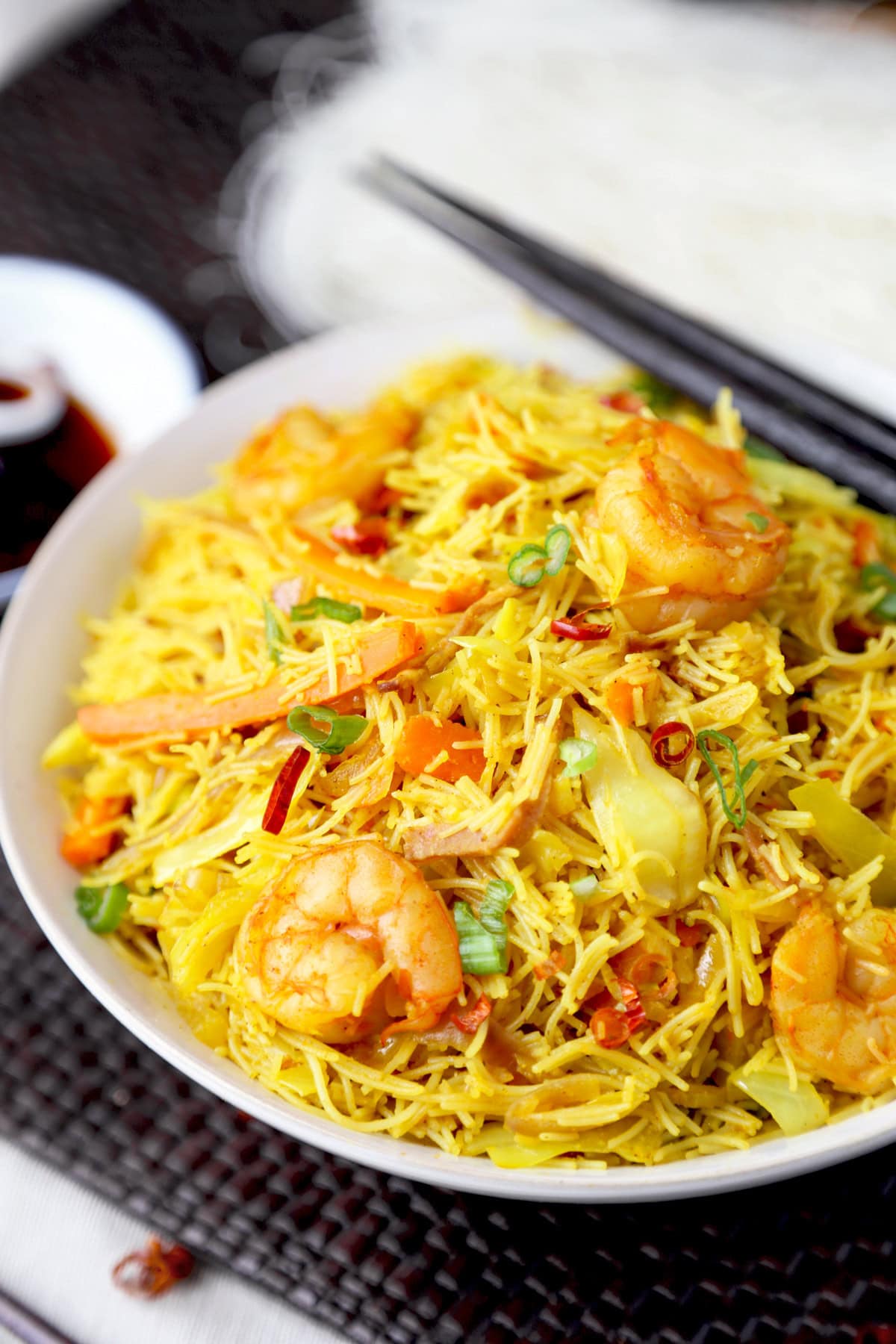
So many years have gone by since I lived in Hong Kong. But one thing that still stands out, two decades later, is how spectacular the food was. It was there that I discovered what good pungent flavors tasted like and where I first tasted these stir fried noodles. While the name would have you believe otherwise, Singapore noodles didn’t originate in Singapore. They are of Cantonese origin – Hong Kong to be exact – and are actually quite similar to a Filipino bihon pancit from an ingredients standpoint! It’s a simple noodle stir fry cooked with vegetables and meats, but what makes it different is the use of curry powder.
Beside loving the flavors, what I also like about this Cantonese dish is it doesn’t require me to go to the Asian supermarket to pick up ingredients I don’t already have in my pantry. These chow mei fun noodles can be made with ingredients that are easy to find for both you and I. The only 5 Asian ingredients needed are: soy sauce, toasted sesame oil, rice vinegar, dried red chilis, and maifun noodles (thin rice noodles).
Table of contents
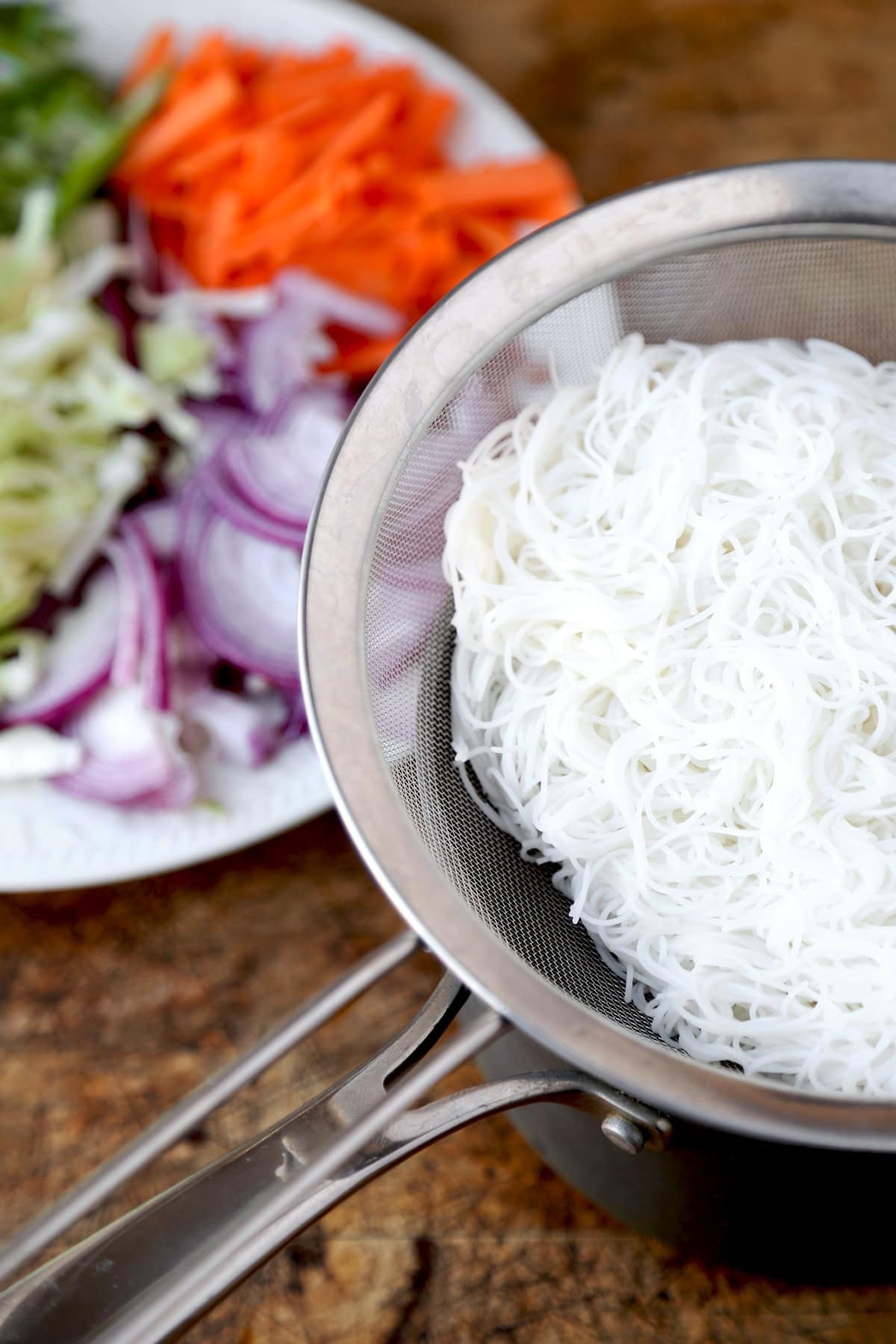
Ingredients
Scroll down to the recipe card for the full recipe.
- Protein: Shrimp and charsiu pork are the traditional proteins used in a Singapore chow mei fun. But I like to swap the pork for turkey bacon because let’s face it – finding charsiu pork can sometimes be a challenging endeavour. I like the subtle flavors of turkey bacon and find that it doesn’t overpower the dish like regular bacon does.
- Vegetables: A mix of sliced cabbage, carrot, and onion. Feel free to add sliced bell peppers and mushrooms to up your intake of veggies!
- Dried red chili peppers: These small chili peppers impart so much flavor to the dish! Only 2 is needed to add plenty of smokiness and a medium level heat.
- Scallions: Scallions and Chinese food are the perfect marriage which is why it’s included in 90% of their dishes. They add a little sweetness and a refreshing crunch.
- Curry powder: The main flavor of this dish come from the earthy and aromatic curry powder. The powder is what makes the dish a vibrant yellow and adds plenty of warmth to it.
- Maifun noodles (dried rice noodles): Used in Asian cuisine – from Mainland China and Hong Kong – to Thailand, Vietnam, Singapore – and most parts in between, maifun noodles, sometimes referred to as rice stick noodles, are thin rice vermicelli noodles.
- Seasoning: A mixture of salt, rice vinegar, toasted sesame oil, and soy sauce.
- White ground pepper: Dusting a little white ground pepper on top of the dish right before serving gives it a slight floral aroma element.
Variations
- Use a different protein. Go ahead and use chicken or beef if you are not big on seafood. Or swap the pork for chicken, or beef for shrimp. You get the idea.
- Make it vegan. Aside from the proteins being used, this dish is 100% vegan. All you need to do is to omit the shrimp and pork, and instead use firm tofu or some plant based meat substitute.
- Make it really spicy. Use chili oil instead of toasted sesame oil to infuse the dish with plenty of heat.
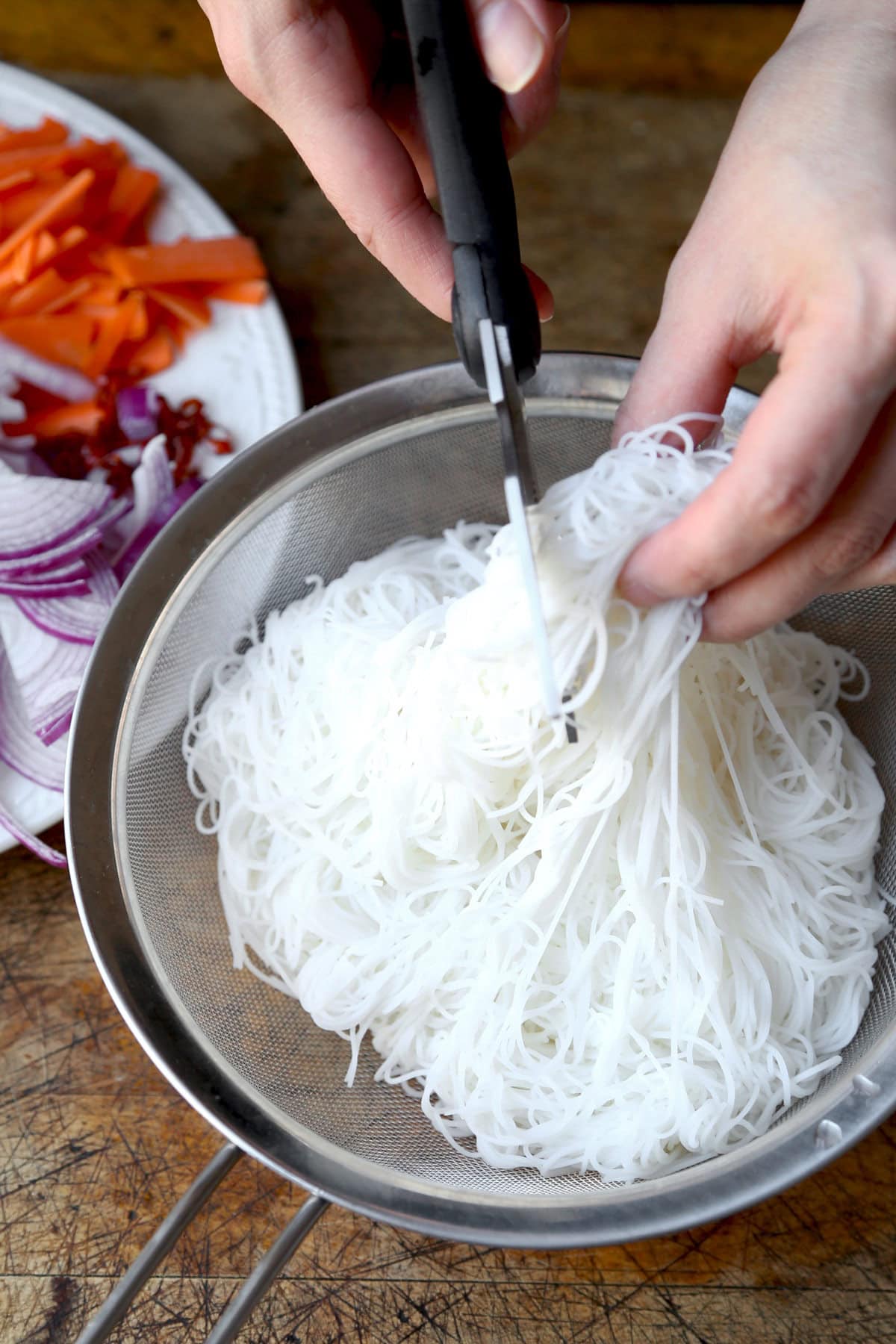
Kitchen Equipment Needed
- Kitchen scissors: Kitchen scissors are needed to cut the long maifun noodles into bite size length.
- Wok or deep skillet: I always feel like a pro when I am tossing food from a wok. But I do prefer using a nonstick deep skillet since less oil is needed.
- Chopsticks or tongues: Something to toss the noodles delicately, so they won’t break.
How To Make These Chow Mei Fun Noodles
- The first step to making Singapore chow mei fun is to soak the noodles. While directions will vary from brand to brand, maifun noodles usually require no actual boiling. Place them in hot water for a few minutes and they should be good to go. Drain them well afterward and let them dry.
- Cook the shrimp and charsiu pork, or turkey bacon, in a large deep skillet. After 30 seconds or so, add the cabbage, carrot, red onion, dried red chili peppers and half of the scallions. Stir fry for 4 minutes.
- Add the curry powder and keep tossing the ingredients.
- Add the rice noodles, salt, rice wine vinegar, toasted sesame oil and soy sauce. Toss everything gently to prevent the noodles from breaking and turn the heat off.
- Serve the noodles on a plate with the remaining scallions and a little ground white pepper. Enjoy!
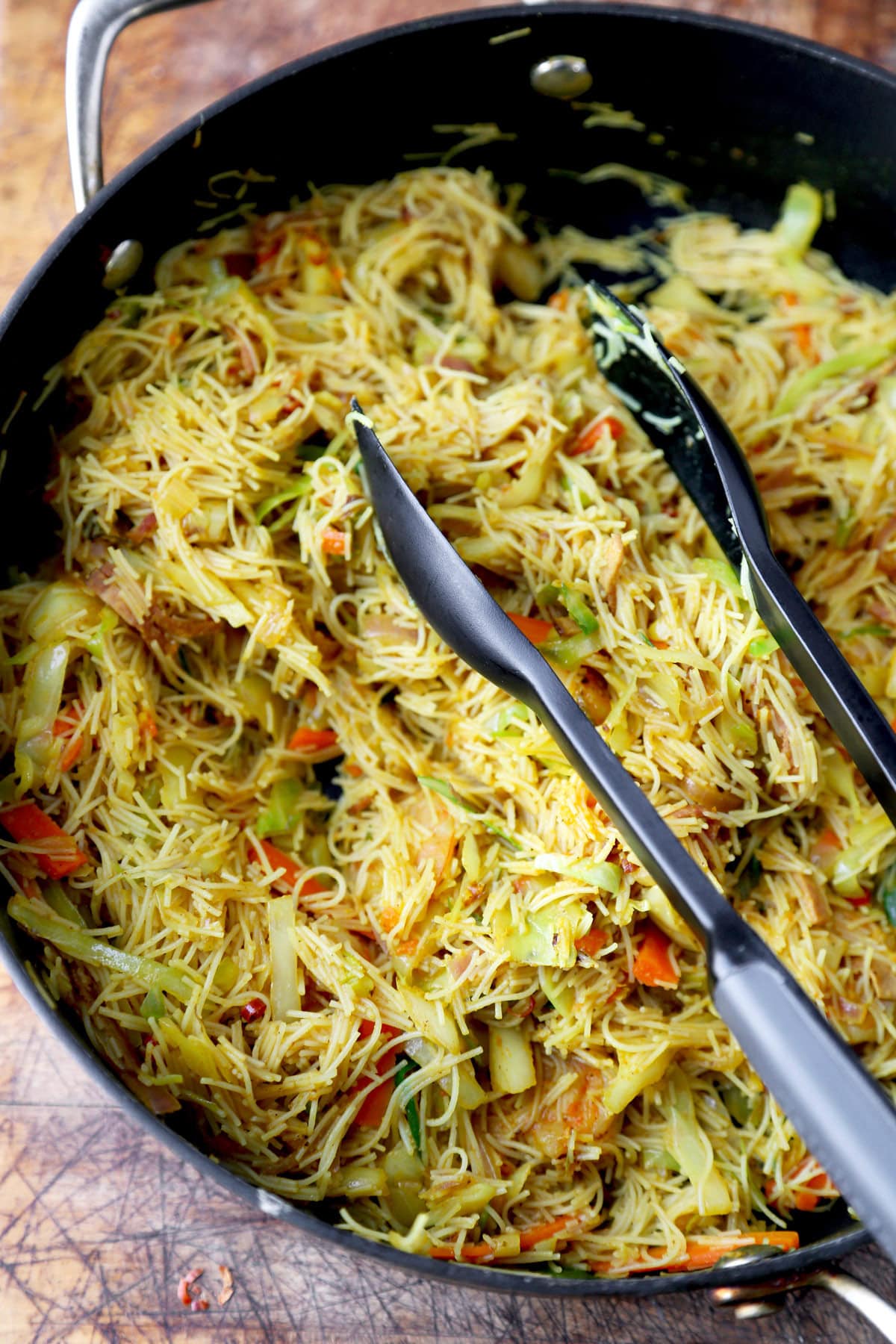
Expert Tips
- Undercook the noodles. When making a stir fry dish, it’s best to slightly undercook maifun noodles at the soaking stage as they will continue to cook when you introduce them to the wok.
- Keep the stirring and tossing to a minimum: The success of this dish relies on the texture of the noodles. So it’s important that they stay somewhat firm. Over tossing them or moving them around too much can make them mushy since they are quite thin and delicate.
Storage
You can make this chow mei fun noodles recipe ahead of time and give it a quick zap in the microwave before serving.
- For leftovers, transfer the stir fried noodles to a storage container. Refrigerate them for up to 3 days.
Because the noodles are so thin, I don’t recommend freezing this dish, as they may get gloopy in the process.
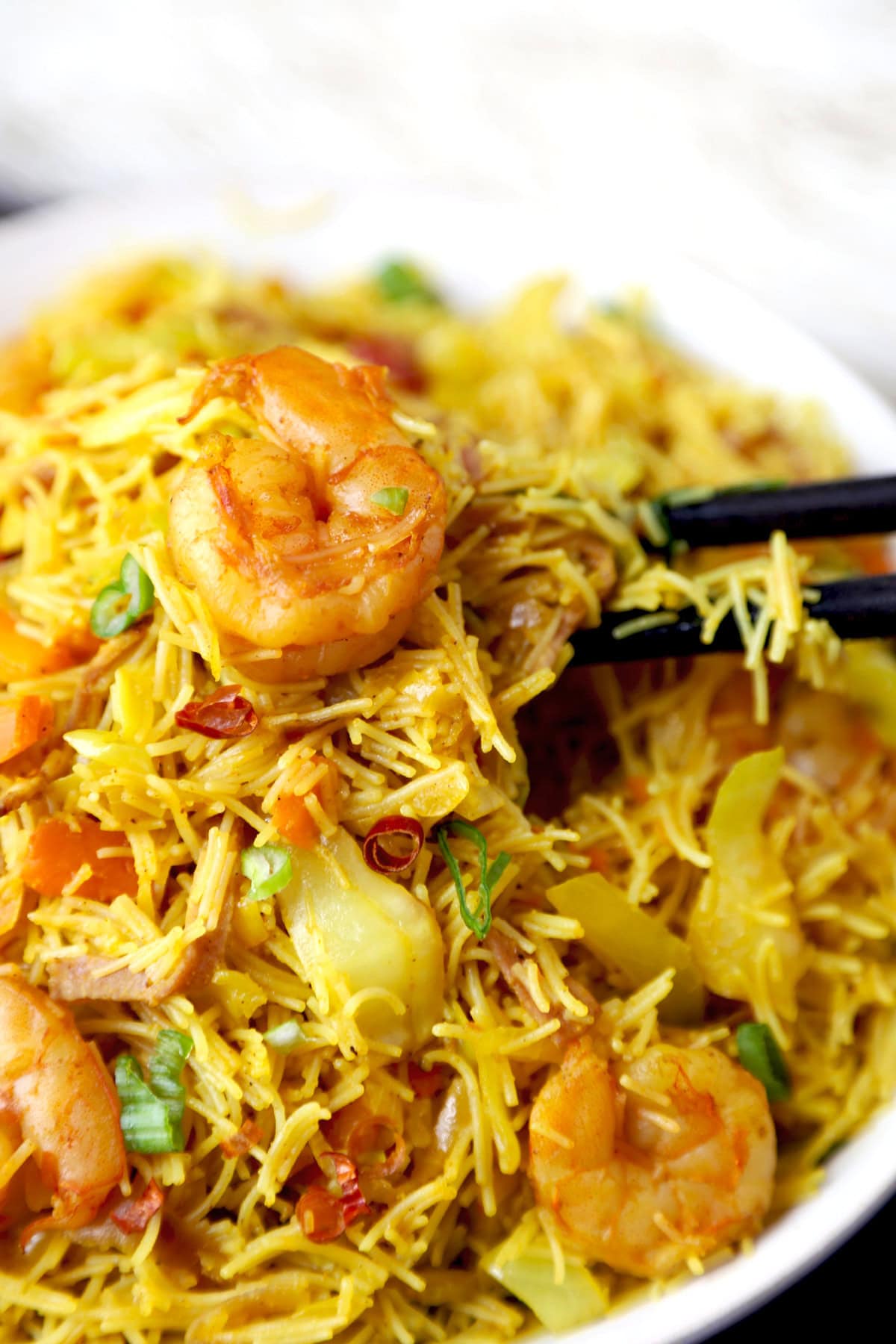
What To Serve With This Dish
This dish is considered casual street food in many parts of Asia, so it’s only fitting that it should be served with other quick stir fries and easy to make dishes. So fire up the wok and, instead of delivery, make an eat-in feast of all your Asian favorites at home!
Here are some of my top picks:
- Honey sriracha tofu
- Sweet and sour tofu
- Chinese green beans with garlic sauce
- Chinese eggplant with garlic sauce
- Chicken egg foo young
- Korean sticky chicken
And if you are in the mood for more stir fried noodles dishes, you might be interested to try this quick vegetable chow mein, tofu chow fun noodles, pan fried noodles with chili crisp, or easy fried noodles with soy sauce.
Frequently Asked Questions
Chow fun noodles are thicker and wider than mei fun noodles. They hold well in stir fries, especially ones that are served with a gooey sauce. Maifun noodles are a better choice for dry stir fries like this one.
It could be that the wok wasn’t hot enough when the noodles were added and as they cooked, slowly stuck to the surface. Or, not enough oil was used (this is the most common reason). Make sure the pan is very hot before adding the oil and then quickly swirl it around to coat the surface evenly. Personally, I don’t like to use a lot of oil which is why I prefer using a nonstick deep skillet.
Using Thai or Vietnamese vermicelli noodles are good options.
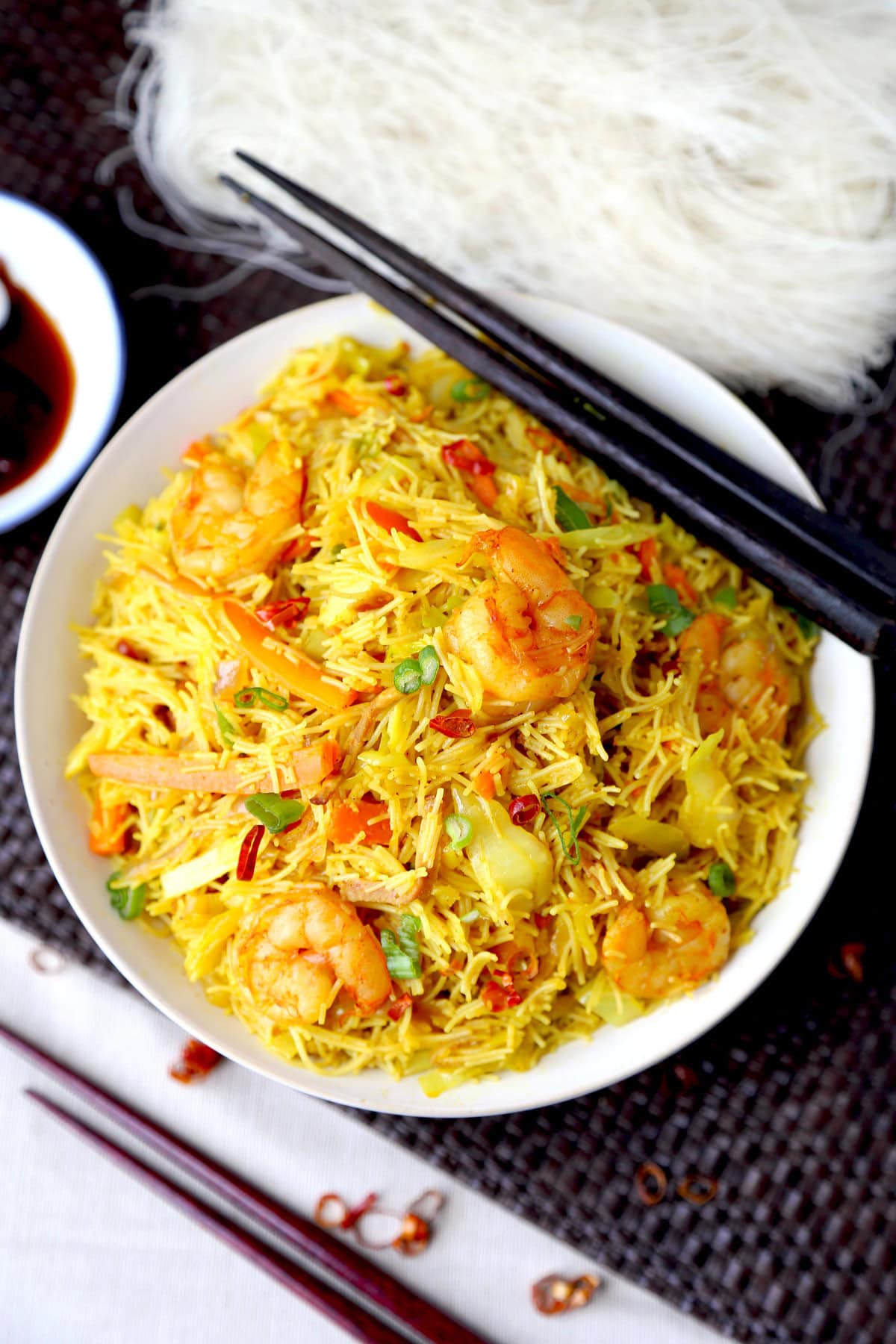
Did you like this recipe? Are there changes you made that you would like to share? Share your tips and recommendations in the comments section below!
Print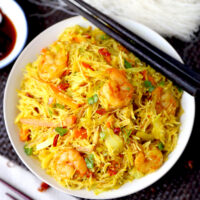
Singapore Chow Mei Fun
- Prep Time: 13 minutes
- Cook Time: 7 minutes
- Total Time: 20 minutes
- Yield: 4 servings 1x
- Category: Stir fry
- Method: Skillet
- Cuisine: Chinese
Description
This is a simplified and better than takeout Singapore chow mei fun recipe your whole family will love. Ready in 20 minutes from start to finish!
Ingredients
- 1 tablespoon vegetable oil
- 10 large shrimp (peeled and deveined)
- 50g charsiu pork or 3 strips turkey bacon, sliced into bite size strips (optional)
- 2 cups cabbage, shredded
- 1 carrot, sliced into thin strips
- 1 small red onion, thinly sliced into half moons
- 2 dried red chili peppers, roughly chopped
- 3 stalks scallions, chopped
- 1 1/2 tablespoons curry powder
- 130 grams maifun noodles (dried rice noodles)
- 1/4 teaspoon salt
- 1 tablespoon rice vinegar
- 1 teaspoon toasted sesame oil
- 1 1/2 tablespoons soy sauce
- Ground white pepper, to taste
Instructions
- Soak the maifun noodles. Soak them in hot water for 7-8 minutes, or until they are al dente. You don’t want them cooked all the way through since you will finish them in the wok.
- Let the noodles dry. Drain the noodles and let them dry. You may gently pat them dry with paper towels to speed up the process.
- Cut the noodles. Use scissors to cut the into a length that’s easy to eat. Set them aside.
- Cook the protein. In a wok or deep skillet over medium high heat, add the oil. When the oil is hot, add the shrimp and turkey bacon and cook for 30 seconds.
- Cook the vegetables. Add the cabbage, carrot, red onion, dried red chili peppers and half of the scallions. Cook for 4 minutes or until the vegetables are tender but still yielding a slight crunch.
- Add seasoning. Add the curry powder and stir.
- Cook the noodles and season some more. Add the maifun noodles, salt, rice vinegar, toasted sesame oil, and soy sauce. Gently toss the noodles to season them evenly.
- Serve them. Turn the heat off and transfer the noodles to a serving plate or bowl. Season with ground white pepper and garnish with the remaining scallions.
Notes
Save these chow mei fun noodles in a storage container and refrigerate for up to 3 days.
Nutrition
- Serving Size: 1 serving
- Calories: 224
- Sugar: 6.2g
- Sodium: 856mg
- Fat: 4.4g
- Saturated Fat: 1.1g
- Unsaturated Fat: 1.3g
- Trans Fat: 0g
- Carbohydrates: 39.8g
- Fiber: 4.6g
- Protein: 7.1g
- Cholesterol: 23.5mg















I enjoy this recipe. I only replace the pork with shaved beef. I marinate the beef in Korean BBQ sauce overnight. So, it’s tender beef. I use less curry powder because it’s too spicy for my husband.
My coworker often brings in pancit with chicken to office parties, but I find it a little bland.I always add chili flakes to gice it some zip. When you mentioned this recipe is like pancit, but spicy with curry powder, my eyes lit up! I have all the ingredients except the cabbage- will try ASAP! Thanks!
I grew up in San Francisco, & discovered this dish on the menu at a restaurant that I used to frequent. I haven’t tried the recipe yet, but it should be pointed out that in the traditional version of this dish, Char siu pork is used instead of bacon. Char siu has it’s own unique blend of spices in it (Chinese five spice, etc.) that help develop the complexity of the flavors. It’s fine to offer healthier alternatives, but for those more interested in the real deal, try chunks of Char siu!
Is there a recipe similar to this that doesn’t have curry in it. I would love something like it.
Hi Christine! You can omit the curry from the recipe, the dish will still be super tasty 🙂
This recipe is a favorite including with our 3 year old and a great way to use up pretty much any vegetable! I highly recommend using actual bacon instead of turkey bacon. It makes the ‘sauce’ (in quotes because it’s a very small amount and the dish should be pretty dry) so delicious. I’ve found you can omit the oil and soy sauce at the end if you use double the bacon called for in the recipe. (just the right amount of Americanization for my family;) ) I also always throw in small pieces of chicken with the shrimp and bacon at the beginning, and scramble in a couple eggs before adding the vegetables.
Wonderful Ellen! Thank you so much for your suggestions and for letting me know that your family enjoys it 🙂
Wow. Super easy to make and substitute the veggies I had on hand. I’m so excited to be able to make this at home! Saving so much $$
I love Chinese food, usually I order it but now I decided to cook it, delicious and so easy, love the noodles i used vermicelli noodles mande with peas, green mung bean starch and water, love it, see tru beans, like glass, very good recipe love it ,I added green frozen peas for extra color, love it thanks for sharing your recipe, take out versions uses to much oil,like your a lot better, will do it again
Thank you so much Marcy! 🙂
My hubby loved this recipe. He even took the rest to work for lunch the next day. This from a man who doesnt eat leftovers!
I only used shrimp csuse I didnt have anything else. Gonna try it again tonite and add turkey bacon.
Thank you. It’s great!
I’d like to see lo mein recipe of you have one. I can’t find a good one anywhere.
That’s wonderful Lori! I have a shrimp lo mein here https://pickledplum.com/shrimp-lo-mein/ I hope you enjoy it too! Thank you for sharing! 🙂
Thanks for posting this wonderful recipe! I made for my family tonight and it was a big hit.
Thank you Molly 🙂
Great recipe. It’s rare a home recipe compares to restaurant Singapore Noodles, but this one does. I made mine with country ham pieces and it was fantastic..
Thank you Paula! 🙂
Hey Caroline, thank you very much for the recipe. I love this dish and I’ll definitely give it a go. The only thing I would recommend though is the change of the brand of rice noodles. It shouldn’t break up easily like that shown in the pic. Good mai fun or mi fen (mandarin) should retain its long strands, if cooked quickly with sufficient oil and high heat. I usually use 3-4 tbsp of oil and the oil is barely there once I’m done. And for a touch of healthy fats, I use avocado oil which is neutral in flavor and healthier than most vegetable oil. I’ll let you know once I cook this. Thanks again! 🙂
Thanks Jo! The noodles were actually good, it’s the photographer (me) who took too long shooting the images 😉 This unfortunately resulted in broken noodles because they had overcooked.
I recommend adding a 1/3 cup of chicken stock at the end, off heat. This is way too dry as is.
When I made this it was SO dry and chalky I had to add 1/2 bottle of store bought ginger dressing to make it work. I followed the recipe to a T and it did not taste like a take our version… any insight?
Hi Laura, traditional Singapore chow mei fun is dry, it’s only made using spices and contains no dressing. I’m not sure what version you are used to, could it be an Americanized version? I know the food served in American Chinese restaurants (which I grew up on) is very different from the food made in Asia (where I spend 8 years) or served in Szechuan restaurants in NYC. Most dishes are usually a lot sweeter and oilier in the US.
Curry powder as in INDIAN curry powder?
Hi Chris, I use the regular yellow curry powder found in the spice aisle of grocerie stores. Like this one: https://www.simplyorganic.com/simply-organic-curry-powder-3-00-oz
Hi..I have tried different recipes for Singapore noodles and it never comes out right…what kind of curry powder do you use?
Hi Preeja, I use Simply Organic curry powder that you can get at your local grocery store. Or you can try making your own, I think it’s fairly easy but I’m too lazy to do it 🙂
I literally get that from take out at least once a week. I’m obsessed with greasy spicy Singapore noodles.
You and Ben would get really well haha!